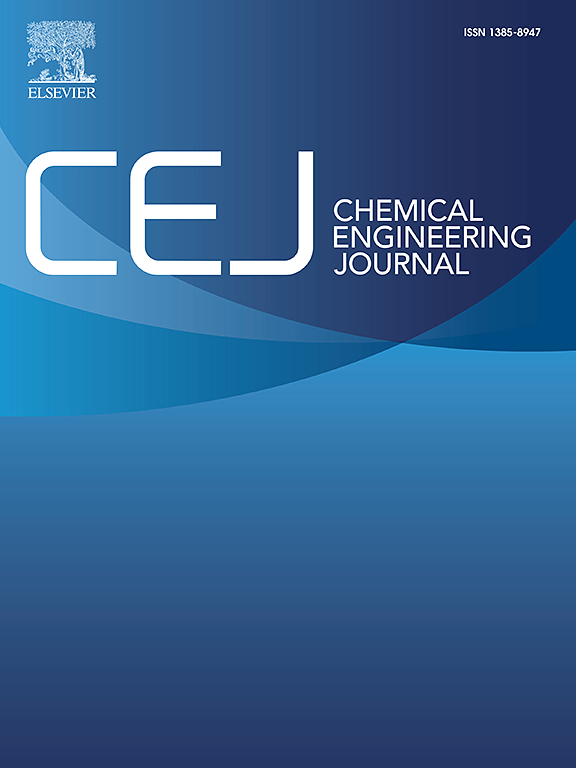Highly elastic, fatigue-resistant and highly conductive poly(lipoic acid)-based liquid-free ionic conductive elastomers for wearable sensors
IF 13.2
1区 工程技术
Q1 ENGINEERING, CHEMICAL
引用次数: 0
Abstract
Flexible ionic conductive elastomers have garnered significant attention owing to their promising applications in flexible wearable devices. The challenges posed by water evaporation in hydrogels and the leakage of ionic liquids in ionogels have motivated researchers to develop liquid-free ionic conductive elastomers (ICEs). However, the development of liquid-free ICEs that simultaneously exhibit excellent resilience, full recyclability, high conductivity, mechanical robustness and self-healing capability presents a significant challenge. Here, a high entanglement network is constructed through the modification of poly(lipoic acid) sidechains and the formation of lithium bonds, which endows ICE with high tensile strength (140 kPa), stretchability (626 % elongation at break), and excellent resilience (96.74 % peak stress retention rate after 1000 cycles at 100 % strain). Notably, the mechanical properties, ionic conductivity, and resilience of ICE can be enhanced simultaneously due to the formation of lithium bonds. Moreover, the ICE features full recyclability (up to three times) and self-healing efficiency (78.1 %). A strain sensor based on the designed ICE enables gesture recognition. The assembled triboelectric nanogenerator based on ICE can detect human motion and encrypt information. This research provides valuable insights into the design of liquid-free ICEs with unparalleled combinatory properties toward reliable and environmentally sustainable wearable flexible device.

用于可穿戴传感器的高弹性、耐疲劳和高导电性聚硫辛酸基无液体离子导电弹性体
柔性离子导电弹性体由于其在柔性可穿戴设备中的应用前景而引起了人们的极大关注。水凝胶中的水分蒸发和离子液体在离子凝胶中的泄漏所带来的挑战促使研究人员开发无液体离子导电弹性体(ICEs)。然而,开发同时具有优异回弹性、完全可回收性、高导电性、机械坚固性和自愈能力的无液体ice是一个重大挑战。在这里,通过聚硫辛酸侧链的修饰和锂键的形成,构建了一个高缠结网络,使ICE具有高抗拉强度(140 kPa),拉伸性(626 %断裂伸长率)和优异的回弹性(在100 %应变下,1000 循环后的峰值应力保留率为96.74 %)。值得注意的是,由于锂键的形成,ICE的机械性能、离子电导率和回弹性可以同时增强。此外,ICE具有完全可回收性(高达三次)和自修复效率(78.1 %)。基于所设计的ICE的应变传感器可实现手势识别。基于ICE的组装摩擦电纳米发电机可以检测人体运动并对信息进行加密。该研究为设计具有无与伦比的组合性能的无液体ICEs提供了有价值的见解,从而实现可靠和环境可持续的可穿戴柔性设备。
本文章由计算机程序翻译,如有差异,请以英文原文为准。
求助全文
约1分钟内获得全文
求助全文
来源期刊

Chemical Engineering Journal
工程技术-工程:化工
CiteScore
21.70
自引率
9.30%
发文量
6781
审稿时长
2.4 months
期刊介绍:
The Chemical Engineering Journal is an international research journal that invites contributions of original and novel fundamental research. It aims to provide an international platform for presenting original fundamental research, interpretative reviews, and discussions on new developments in chemical engineering. The journal welcomes papers that describe novel theory and its practical application, as well as those that demonstrate the transfer of techniques from other disciplines. It also welcomes reports on carefully conducted experimental work that is soundly interpreted. The main focus of the journal is on original and rigorous research results that have broad significance. The Catalysis section within the Chemical Engineering Journal focuses specifically on Experimental and Theoretical studies in the fields of heterogeneous catalysis, molecular catalysis, and biocatalysis. These studies have industrial impact on various sectors such as chemicals, energy, materials, foods, healthcare, and environmental protection.
 求助内容:
求助内容: 应助结果提醒方式:
应助结果提醒方式:


